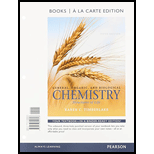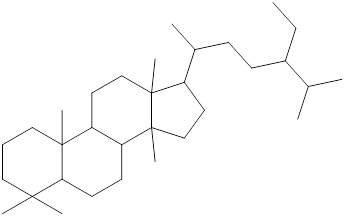
Interpretation: Among the given substances classify them as fatty acids, soaps, triacylgrycerol, wax, glycerophospholipid, sphingolipid, or steroid
Concept Introduction: A substance can be classified in to any of the classifications by looking at the functional groups they contain.
Fatty Acids = A long chain hydrocarbon which consists of carboxylic (-COOH) group in the terminal of the chain.
Soaps = A long chain hydrocarbon which consists of sodium or Potassium salt of carboxylic acid (-COONa or -COOK) in the terminal of the chain.
Triacylglycerols = They are compounds that are synthesized by condensation of a glycerol and 3 equivalents of fatty acid. They are generally esters formed by reaction between alcohols and acids.
Wax = They are long chain hydrocarbons that are composed of fatty acids, alcohols and double bonds.
Glycerophospholipid = They are compounds that are synthesized by condensation of a glycerol, 2 equivalents of fatty acid and 1 phosphate group attached to the third –OH group present in glycerol.
Sphingolipid = Sphingolipid is member of a class of lipids containing the organic aliphatic amino alcoholsphingosine.
Steroid = They are compounds with 4 alkyl rings arranged in specific geometry and they have alkyl substituents substituted at specific positions. The specific geometry is:

To classify: beeswax, cholesterol, lechitin, glyceroltripalmite, sodium stearate, safflower oil as fatty acids, soaps, triacylgrycerol, wax, glycerophospholipid, sphingolipid, or steroid
Want to see the full answer?
Check out a sample textbook solution
Chapter 17 Solutions
General, Organic, and Biological Chemistry: Structures of Life, Books a la Carte Plus Mastering Chemistry with eText -- Access Card Package (5th Edition)
 ChemistryChemistryISBN:9781305957404Author:Steven S. Zumdahl, Susan A. Zumdahl, Donald J. DeCostePublisher:Cengage Learning
ChemistryChemistryISBN:9781305957404Author:Steven S. Zumdahl, Susan A. Zumdahl, Donald J. DeCostePublisher:Cengage Learning ChemistryChemistryISBN:9781259911156Author:Raymond Chang Dr., Jason Overby ProfessorPublisher:McGraw-Hill Education
ChemistryChemistryISBN:9781259911156Author:Raymond Chang Dr., Jason Overby ProfessorPublisher:McGraw-Hill Education Principles of Instrumental AnalysisChemistryISBN:9781305577213Author:Douglas A. Skoog, F. James Holler, Stanley R. CrouchPublisher:Cengage Learning
Principles of Instrumental AnalysisChemistryISBN:9781305577213Author:Douglas A. Skoog, F. James Holler, Stanley R. CrouchPublisher:Cengage Learning Organic ChemistryChemistryISBN:9780078021558Author:Janice Gorzynski Smith Dr.Publisher:McGraw-Hill Education
Organic ChemistryChemistryISBN:9780078021558Author:Janice Gorzynski Smith Dr.Publisher:McGraw-Hill Education Chemistry: Principles and ReactionsChemistryISBN:9781305079373Author:William L. Masterton, Cecile N. HurleyPublisher:Cengage Learning
Chemistry: Principles and ReactionsChemistryISBN:9781305079373Author:William L. Masterton, Cecile N. HurleyPublisher:Cengage Learning Elementary Principles of Chemical Processes, Bind...ChemistryISBN:9781118431221Author:Richard M. Felder, Ronald W. Rousseau, Lisa G. BullardPublisher:WILEY
Elementary Principles of Chemical Processes, Bind...ChemistryISBN:9781118431221Author:Richard M. Felder, Ronald W. Rousseau, Lisa G. BullardPublisher:WILEY





